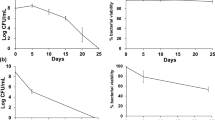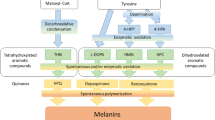Abstract
The conversion of isopenicillin N into penicillin N in Acremonium chrysogenum is catalyzed by an epimerization system that involves an isopenicillin N-CoA synthethase and isopenicillin N-CoA epimerase, encoded by the genes cefD1 and cefD2. Several transformants containing two to seven additional copies of both genes were obtained. Four of these transformants (TMCD26, TMCD53, TMCD242 and TMCD474) showed two-fold higher IPN epimerase activity than the untransformed A. chrysogenum C10, and produced 80 to 100% more cephalosporin C and deacetylcephalosporin C than the parental strain. A second class of transformants, including TMCD2, TMCD32 and TMCD39, in contrast, showed a drastic reduction in cephalosporin biosynthesis relative to the untransformed control. These transformants had no detectable IPN epimerase activity and did not produce cephalosporin C or deacetylcephalosporin C. They also expressed both endogenous and exogenous cefD2 genes only after long periods (72–96 h) of incubation, as shown by Northern analysis, and were impaired in mycelial branching in liquid cultures. The negative effect of amplification of the cefD1 - cefD2 gene cluster in this second class of transformants is not correlated with high gene dosage, but appears to be due to exogenous DNA integration into a specific locus, which results in a pleiotropic effect on growth and cefD2 expression.





Similar content being viewed by others
References
Aharonowitz Y, Cohen G, Martín JF (1992) Penicillin and cephalosporin biosynthetic genes: structure, organization, regulation and evolution. Annu Rev Microbiol 46:461–495
Barredo JL, Díez E, Álvarez E, Martín JF (1989) Large amplification of a 35-kb DNA fragment carrying two penicillin biosynthetic genes in high penicillin producing strains of Penicillium chrysogenum. Curr Genet 16:453–459
Bradford MM (1976) A rapid and sensitive method for the quantitation of microgram quantities of protein utilizing the principle of protein-dye binding. Anal Biochem 72:248–254
Díez B, Barredo JL, Álvarez E, Cantoral JM, van Solingen P, Groenen MA, Veenstra AE, Martín JF (1989) Two genes involved in penicillin biosynthesis are linked in a 5.1-kb Sal I fragment in the genome of Penicillium chrysogenum. Mol Gen Genet 218:572–576
Elander RP (2003) Industrial production of β-lactam antibiotics. Appl Microbiol Biotechnol 61:385–392
Fernández-Cañón JM, Peñalva MA (1995) Overexpression of two penicillin structural genes in Aspergillus nidulans. Mol Gen Genet 246:110–118
Fierro F, Barredo JL, Díez B, Fernández FJ, Martín JF (1995) The penicillin gene cluster is amplified in tandem repeats linked by conserved hexanucleotide sequences. Proc Natl Acad Sci USA 92:6200–6204
Gutiérrez S, Díez B, Álvarez E, Barredo JL, Martín JF (1991a) Expression of the pen DE gene of Penicillium chrysogenum encoding isopenicillin N acyltransferase in Cephalosporium acremonium: production of benzylpenicillin by the transformants. Mol Gen Genet 225:56–64
Gutiérrez S, Díez B, Montenegro E, Martín JF (1991b) Characterization of the Cephalosporium acremonium pcbAB gene encoding α-aminoadiyl-cysteinyl-valine synthetase, a large multidomain peptide synthetase: Linkage to the pcbC gene as a cluster of early cephalosporin-biosynthetic genes and evidence of multiple functional domains. J Bacteriol 173:2354–2365
Gutiérrez S, Velasco J, Fernández FJ, Martín JF (1992) The cefG gene of Cephalosporium acremonium is linked to the cefEF gene and encodes a deacetylcephalosporin C acetyltransferase closely related to homoserine O-acetyltransferase. J Bacteriol 174:3056–3064
Gutiérrez S, Velasco J, Marcos AT, Fernández FJ, Fierro F, Díez B, Barredo JL, Martín JF (1997) Expression of the cefG gene is limiting for cephalosporin biosynthesis in Acremonium chrysogenum. Appl Microbiol Biotechnol 48:606–614
Gutiérrez S, Fierro F, Casqueiro J, Martín JF (1999) Gene organization and plasticity of the β-lactam genes in different filamentous fungi. Antonie van Leeuwenhoek 75:81–94
Jensen SE, Westlake DWS, Wolfe S (1983) Partial purification and characterization of isopenicillin N epimerase activity from Streptomyces clavuligerus. Can J Microbiol 29:1526–1531
Kennedy J, Turner G (1996) Δ-(L-α-aminoadipyl)-L-cysteinyl-D-valine synthetase is a rate limiting enzyme for penicillin production in Aspergillus nidulans. Mol Gen Genet 253:189–197
Knihinicki RD, Day RO, Williams KM (1991) Chiral inversion of 2-arylpropionic acid non-steroidal anti-inflamatory drugs II. Racemization and hydrolysis of (R)- and (S)-ibuprofen-CoA thioesters. Biochem Pharmacol 42:1905–1911
Láiz L, Liras P, Castro JM, Martín JF (1990) Purification and characterization of the isopenicillin N epimerase from Nocardia lactamdurans. J Gen Microbiol 136:663–671
Lübbe C, Wolfe S, Demain AL (1986) Isopenicillin N epimerase activity in a high cephalosporin-producing strain of Cephalosporium acremonium. Appl Microbiol Biotechnol 23:367–368
Martín JF, Demain AL (2002) Unraveling the methionine-cephalosporin puzzle in Acremonium chrysogenum. Trends Biotechnol 20:502–507
Martín JF, Ullán RV, Casqueiro J (2004) Novel genes involved in cephalosporin biosynthesis: the three-component isopenicillin N epimerase system. In: Brakhage A (ed) Molecular biotechnology of fungal beta-lactam antibiotics and related peptide synthetases (Advances in biochemical engineering and biotechnology, vol 88). Springer, Heidelberg, pp 91–110
Nash CH, Huber FM (1971) Antibiotic synthesis and morphological differentiation of Cephalosporium acremonium. Appl Microbiol 22:6–10
Neuss N, Berry DM, Kupka J, Demain AL, Queener SW, Duckworth DC, Huckstep LL (1982) High performance liquid chromatography (HPLC) of natural products. V. The use of HPLC in the cell-free biosynthetic conversion of alpha-aminoadipyl-cysteinyl-valine (LLD) into isopenicillin N. J Antibiot 35:580-584
Newbert RW, Barton B, Greaves P, Harper J, Turner G (1997) Analysis of a commercially improved Penicillium chrysogenum strain series: involvement of recombinogenic regions in amplification and deletion of penicillin biosynthesis gene cluster. J Ind Microbiol Biotechnol 19:18–27
Ramos FR, López-Nieto JM, Martín JF (1986) Coordinate increase of isopenicillin N synthetase, isopenicillin N epimerase and deacetoxycephalosporin C synthetase in a high cephalosporin-producing mutant of Acremonium chrysogenum and simultaneous loss of the three enzymes in a non-producing mutant. FEMS Microbiol Lett 35:123-127
Rodríguez-Sáiz M, Lembo M, Bertetti L, Muraca R, Velasco J, Malcangi A, de la Fuente JL, Barredo JL (2004) Strain improvement for cephalosporin production by Acremonium chrysogenum using geniticin as a suitable transformation marker. FEMS Microbiol Lett 235:43–49
Sambrook J, Fritsch EF, Maniatis T (1989) Molecular cloning: a laboratory manual. Cold Spring Harbor Laboratory Press, Cold Spring Harbor, N.Y.
Schmitz W, Albers C, Fingerhut R, Conzelmann E (1995) Purification and characterization of an α-methylacyl-CoA racemase from human liver. Eur J Biochem 231:815–822
Shen YQ, Wolfe S, Demain AL (1986) Levels of isopenicillin N synthetase and deacetoxycephalosporin C synthetase in Cephalosporium acremonium producing high and low levels of cephalosporin C. Biotechnology 4:61–64
Shieh WR, Chen CS (1993) Purification and characterization of novel 2-arylpropionyl-CoA epimerases from rat liver cytosol and mitochondria. J Biol Chem 268:3487–3493
Skatrud PL, Tiezt AJ, Ingolia TD, Cantwell CA, Fisher DL, Chapman JL, Queener SW (1989) Use of recombinant DNA to improve production of cephalosporin C by Cephalosporium acremonium. Biotechnology 7:476–485
Ullán RV, Casqueiro J, Bañuelos O, Fernández FJ, Gutiérrez S, Martín JF (2002) A novel epimerization system in fungal secondary metabolism involved in the conversion of isopenicillin N into penicillin N in Acremonium chrysogenum. J Biol Chem 277:46216–46225
Velasco J, Gutiérrez S, Campoy S, Martín JF (1999) Molecular characterization of the Acremonium chrysogenum cefG gene product: the native deacetylcephalosporin C acetyltransferase is not processed into subunits. Biochem J 337:379–385
Verdoes JC, van Diepeningen AD, Punt PJ, Debets AJ, Stouthamer AH, van den Hondel CA (1994) Evaluation of molecular and genetic approaches to generate glucoamylase overproducing strains of Aspergillus niger. J Biotechnol 36:165–175
Zanca DN, Martín JF (1983) Carbon catabolic regulation of the conversion of penicillin N into cephalosporin C. J Antibiot 36:700–708
Acknowledgements
This work was supported by a Grant of the Spanish Ministry of Science and Technology, Madrid (BIO2000-0060-P4-03). I. Vaca received a fellowship from the Diputación de León
Author information
Authors and Affiliations
Corresponding author
Additional information
Communicated by P. J. Punt
Rights and permissions
About this article
Cite this article
Ullán, R.V., Casqueiro, J., Naranjo, L. et al. Expression of cefD2 and the conversion of isopenicillin N into penicillin N by the two-component epimerase system are rate-limiting steps in cephalosporin biosynthesis. Mol Genet Genomics 272, 562–570 (2004). https://doi.org/10.1007/s00438-004-1087-4
Received:
Accepted:
Published:
Issue Date:
DOI: https://doi.org/10.1007/s00438-004-1087-4




